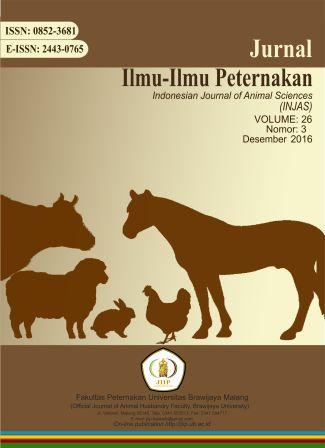Proporsi penggunaan berbagai jenis daun tanaman untuk pakan ternak kambing pada lokasi dan ketinggian berbeda di wilayah Malang Raya
DOI:
https://doi.org/10.21776/ub.jiip.2016.026.03.07Abstract
This research aims at investigating the proportion of several types of tree foliages leaves as animal feed in different locations and altitudes in Malang Raya. The case study was conducted in five districts of Malang Raya where were assumed as the centre of goat farms. The results showed that there were 30 types of forage used as goat feeds, both leaves of tree foliages and shrubs, or grasses, crop residues and others. Most forages (73%) were leaves of tree foliages and shrubs, both legumes, and non-legumes. Tree foliage leaves were more used as goat feeds in the study area with higher altitude, whereas in the area with lower altitude, farmers also utilized grasses and crop residues. The leaves of tree foliages were Paraserianthes falcataria, Gliricidia sepium, Artocarpus heterophyllus, Leucaena leucocephala and Calliandra calothyrsus. Paraserianthes falcataria was most widely used in Klampok-Singosari (88.3%). The proportion of Calliandra calothyrsus ranged from 32 to 98%, while Gliricidia sepium was 58-98%, both were most widely used in Argoyuwono-Ampelgading. Artocarpus heterophyllus was most widely used in Wajak (90.3%), whereas Leucaena leucocephala leaf was used by all respondents (100%) in Sumberdem-Wonosari. It is necessary to evaluate the quality of these tree foliage leaves to provide a better animal feed through supplementation technology.
Â
Keyword: altitudes, foliages, leave, locationDownloads
Published
How to Cite
Issue
Section
License
Authors who publish with this journal agree to the following terms:- Authors retain copyright and grant the journal right of first publication with the work simultaneously licensed under a Creative Commons Attribution License that allows others to share the work with an acknowledgment of the work's authorship and initial publication in this journal.
- Authors are able to enter into separate, additional contractual arrangements for the non-exclusive distribution of the journal's published version of the work (e.g., post it to an institutional repository or publish it in a book), with an acknowledgment of its initial publication in this journal.
- Authors are permitted and encouraged to post their work online (e.g., in institutional repositories or on their website) prior to and during the submission process, as it can lead to productive exchanges, as well as earlier and greater citation of published work (See The Effect of Open Access).
















